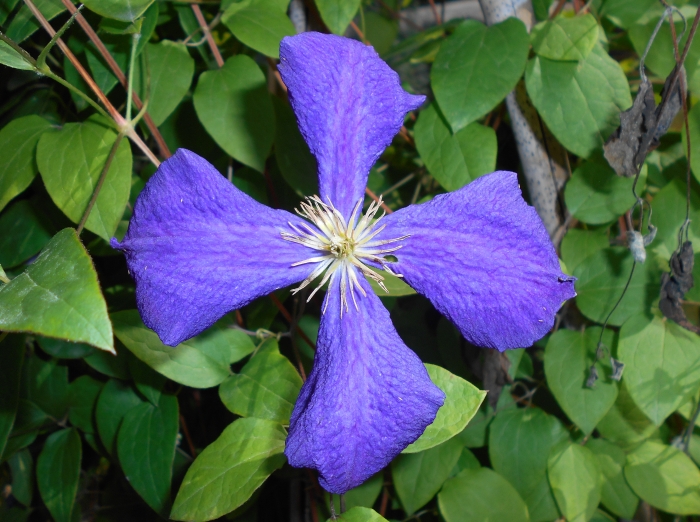Jackman’s Clematis
(Clematis ×jackmanii)
Jackman’s Clematis (Clematis ×jackmanii)
/
/

Salicyna
CC BY-SA 4.0
Image By:
Salicyna
Recorded By:
Copyright:
CC BY-SA 4.0
Copyright Notice:
Photo by: Salicyna | License Type: CC BY-SA 4.0 | License URL: https://creativecommons.org/licenses/by-sa/4.0 | Uploader: Salicyna | Publisher: Wikimedia Commons | Title: Clematis_jackmanii_2015-07-15_4543.jpg | Notes: Uploaded own work with UploadWizard |
















Estimated Native Range
Summary
Clematis ×jackmanii, commonly known as Jackman’s Clematis, is a deciduous perennial vine resulting from a cross of C. lanuginosa, C. viticella, and possibly C. hendersonii. This cultivar was the first of the modern large-flowered hybrid clematises introduced to gardens in 1862 by horticulturalist George Jackman. Jackman’s Clematis typically climbs with the aid of leaf tendrils and boasts large, showy violet-purple flowers that bloom profusely from mid to late summer, making it a favorite among gardeners for its ornamental value.
The plant is highly valued for its ability to provide vertical interest in the garden, covering structures such as trellises, fences, arbors, porch pillars, and lampposts with a profusion of blooms. It is particularly well-suited to the Eastern and Midwest regions of North America, where it is hardy to USDA Zone 4a. The vine thrives when the soil is kept moist and the roots are shaded, which can be achieved with mulch or a large flat rock. Pruning in early spring encourages a flush of new growth, which is essential for flowering, as it blooms on the current year’s growth. Pruning techniques can create a column of bloom by cutting stems at varying heights. Clematis ’Jackmanii’ prefers full sun to part shade and requires soils with medium drainage. While it is generally easy to maintain, it can be susceptible to clematis wilt and should be monitored for signs of disease.CC BY-SA 4.0
The plant is highly valued for its ability to provide vertical interest in the garden, covering structures such as trellises, fences, arbors, porch pillars, and lampposts with a profusion of blooms. It is particularly well-suited to the Eastern and Midwest regions of North America, where it is hardy to USDA Zone 4a. The vine thrives when the soil is kept moist and the roots are shaded, which can be achieved with mulch or a large flat rock. Pruning in early spring encourages a flush of new growth, which is essential for flowering, as it blooms on the current year’s growth. Pruning techniques can create a column of bloom by cutting stems at varying heights. Clematis ’Jackmanii’ prefers full sun to part shade and requires soils with medium drainage. While it is generally easy to maintain, it can be susceptible to clematis wilt and should be monitored for signs of disease.CC BY-SA 4.0
Plant Description
- Plant Type: Vines
- Height: 6-15 feet
- Width: 0.5-6 feet
- Growth Rate: Moderate
- Flower Color: Purple
- Flowering Season: Summer, Fall
- Leaf Retention: Deciduous
Growth Requirements
- Sun: Full Sun, Part Shade
- Water: Medium
- Drainage: Medium
Common Uses
Bee Garden, Bird Garden, Butterfly Garden, Deer Resistant, Fragrant, Hummingbird Garden, Rabbit Resistant, Showy Flowers, Street Planting
Natural Habitat
Garden origin
Other Names
Common Names:
Scientific Names: Clematis ×jackmanii , Clematis ×intermedia , Clematis ×contorta , Clematis ×jackmanii var. rubroviolacea
GBIF Accepted Name: Clematis ×jackmanii T.Moore